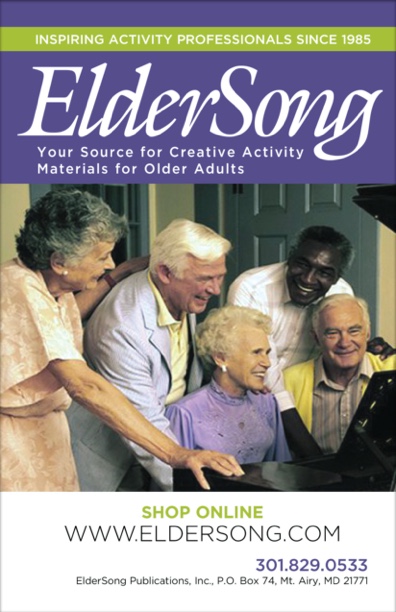Nancy Drew, the Hardy Boys, Tom Swift, the Bobbsey Twins. As a youngster, did you ever stay up past your bedtime reading a mystery under the covers? Generations of readers know how easy it is to become totally engrossed in a new book. What’s on your list of “good reads”? And what’s the best place to read? Engage your group of older adults in some meaningful activities on the theme of “Books and Nooks.” The suggestions below will rekindle memories of early childhood favorites as well as timeless classics.
- Reminisce: Reminisce about favorite times and places to read a book as a child and adult. Start the conversation with the following words: tree house, front porch swing, car seat, family couch, library carrel, bookstore café, lounger, beach chair, bed, hammock. Ask group members to describe a cozy setting to curl up with a good book – quilt or throw, overstuffed chair, footstool, lamp or light.
- Reminisce: Pass around a vintage photo of children carrying school books in a book bag/carrier and copies of old reading books such as McGuffey Readers or Dick and Jane primers. Ask: How did you learn to read? Did you enjoy reading as a child? Can you name a teacher who opened up the world of reading for you? What books you were required to read in school? Sing the chorus to “School Days” and talk about old grammar, arithmetic, history, spelling, and penmanship books.
- Reminisce: Engage your group in simple conversation. Ask: Have you ever been called a bookworm? Read a book in one sitting? Attended a book signing and met a famous author? Organized a book drive or fair? Donated books to a local charity? Lost a library book? Given books as gifts? Bought a first edition or rare book? Browsed for used books at a flea market or garage sale? Inherited a special book from a family member? Read a book over 1,000 pages?
- Reminisce: Pass around some copies of Big Little Books, which first appeared during the Depression. Ask if anyone remembers purchasing the books at Woolworth’s or another five-and-dime store and how much they cost. Did they ever receive the books as Christmas gifts? Who were their favorite story characters? Has anyone passed on a collection of Big Little Books to their children or grandchildren?
- Activity: Gather and display props related to reading books: hard/paperback copies of classics and special-interest books, illustrated children’s books, reading light/glasses, bookmarks, bookends, library card, photos of small-town bookstore and bookmobile, latest New York Times Best-Sellers list. Ask: Do you enjoy reading books? How often do you read them? What’s the name of your all-time favorite book? Do you prefer large chain booksellers or “Mom and Pop” bookstores? Did you ever belong to the Book-of-the-Month Club or another mail-order book club? Talk about the library in your hometown or the traveling bookmobile in a rural community.
- Activity: Invite someone in the group to show his or her family Bible. Talk about keeping a record of family history – births, marriages, deaths – in a Bible and passing the “heirloom” to another generation. Make a bookmark with a favorite Bible verse. Read aloud familiar passages from the “Good Book” – comforting words from the Psalms or wisdom found in the book of Proverbs.
- Activity: Hold a slogan contest: Ask participants to create a catchy slogan to promote reading to children. (Familiar example: “Reading is FUNdamental.”) Vote on the favorite of the group. Talk about the benefits of reading and how to instill a love of reading in children.
- Activity: Display books from the legendary Hardy Boys and Nancy Drew series. Ask your group if they like to solve mysteries. List words associated with mystery or detective stories (ex: clue, motive, alibi, suspect, investigate, detective, sleuth). Watch some episodes of The Hardy Boys/Nancy Drew Mysteries TV series, which aired during the late 1970s. Or listen to an audio book from the series. Talk about mystery series favorites for adult readers.
- Activity: Start a reading group in your facility. (Use large print, audio books, or e-books, as needed.) Vary the activities: Ask for a volunteer to lead a discussion of a featured book. Write a book review and publish it in a monthly newsletter. Complete a word search or crossword puzzle based on the book’s theme/characters/setting. Create a collage of a favorite scene from the book. Rewrite the ending of the book.
- Activity: Play a game of Charades using book titles in a unique way. Examples: Act out classic book titles with numbers in them (20,000 Leagues Under the Sea) or names of novels about horses (Black Beauty).
- Guest Speaker: Invite a local book author, publisher, or librarian to talk about the future of print books, bookstores, and libraries. Demonstrate how to use an e-reader device. Ask participants if they have ever purchased a book from an online bookseller, like Amazon.
- Music: Listen to the show tune “I Could Write a Book” by Rodgers and Hart. Talk about the meaning of the lyrics. Ask group members what would be their storyline for a book. Which book genre do they prefer – romance, mystery, western, biography, science fiction?
- Discussion: Explain the following quotation by Ralph Waldo Emerson: “Many times the reading of a book has made the future of a man.” Ask group members to name some 20th century books that impacted the lives of Americans. (Examples: The Feminine Mystique, The Common Sense Book of Baby and Child Care, Roots: The Saga of an American Family). Ask someone to talk about the significance of a book in his or her life.
- Discussion: Read the short poem “There Is No Frigate Like a Book” by Emily Dickinson. Talk about reading a book that took you on an adventure to a faraway land.
- Discussion: Explain the adage: Judge not a book by its cover. Ask if anyone has ever bought a book based on its book jacket (“cover”) rather than content. For fun: Design a new book jacket for an old novel, using magazines and catalog pictures.
- Intergenerational Halloween Activity: Host a fairy tale costume party – with princesses, princes, knights, fairies, wizards, dwarfs, dragons. Read aloud stories from Grimms’ Fairy Tales. Write a new tale beginning with “Once upon a time” and ending with “happily ever after.” Play musical chairs using Disney songs from fairy tale movies. Hold a treasure hunt for fairy tale objects such as crowns, wands, rings, and “glass” slippers.
- Movie: Compare a classic novel with its movie version. (Example: 1941 book My Friend Flicka by Mary O’Hara and the 1943 film version.)
BOOKS FROM THE 1950s QUIZ
- Who is the author of the amusing book titled Kids Say the Darndest Things!? Art Linkletter
- Which U.S. president wrote a bestseller called Profiles in Courage? John Kennedy
- Finish the title of this popular book by Ernest Hemingway: The Old Man and the…. Sea
- What is the subject of Jean Kerr’s book of essays called Please Don’t Eat the Daisies? Life of a suburban mother with four boys
- 5. In what popular novel did J.D. Salinger introduce the rebel character Holden Caulfield? Catcher in the Rye
- John Steinbeck’s book East of Eden was first published in 1952. Name some other books by the author. Grapes of Wrath, Of Mice and Men, Travels With Charley
- Which author wrote the popular children’s book The Cat in the Hat? Theodor Geisel (known as Dr. Seuss)
- 8. What inspirational book by The Rev. Dr. Norman Vincent Peale became a bestseller in the 1950s? The Power of Positive Thinking
- What is the setting of Caine Mutiny by Pulitzer-Prize winner Herman Wouk? World War II U.S. Navy ship
- The Holy Bible: Revised Standard Version was a bestseller during the decade of the Fifties. What’s the name of the last book in the whole Bible? Revelation
THOUGHT FOR THE MONTH
“Books are the treasured wealth of the world and the fit inheritance of generations and nations.” ~ Henry David Thoreau
“BOOKS AND NOOKS” written by Sue Hansen. © 2012 ElderSong Publications, Inc. All rights reserved.
Reprint Policy: To reprint or republish all or portions of this entry, you must acquire written permission and agree to link back to the original source. Please contact us at [email protected] to obtain permission.


